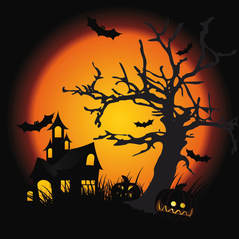
Thanks to YouTube, there are plenty of recordings of well-known Classical pieces that are used often around Halloween--your students might recognize them from movies, commercials, or TV shows.
HERE is a fun YouTube playlist of several Halloween favorites that you can share and discuss with your students. My favorites from the playlist include "Toccata in D Minor" by Bach, "In the Hall of the Mountain King" by Grieg, "Night on Bald Mountain" by Mussorgsky, "O Fortuna" by Carl Orff, and "Danse Macabre" by Saint-Saens.
Encourage your students to listen to the pieces from the playlist, or listen to portions in your lessons over the next two weeks. Ask your students: do any of the pieces sound familiar? Do you recognize the names of any of the composers? What story do you think the composer is telling in each piece?
Listening to these familiar classics can also give students insight into how composers think. What techniques did the composers use to make these pieces sound spooky? As you listen to each piece, ask students to consider the following characteristics:
- Mode: This is the most obvious characteristic of spooky music--the use of the minor mode! For a fun experiment, play for your students the opening motive from Bach's Toccata in D minor, first in the original key (D-C-D, C-Bb-A-G-F#-G), then in D major. Just changing two notes makes a big difference! How many pieces on the playlist are in the minor mode?
- Instrumentation: The instrument a composer uses for a piece makes a big difference as well. Going back to our Bach example, what if that famous opening melody were played by the tuba instead of the organ? It would sound pretty comical, wouldn't it? The use of the organ in the piece creates an extra layer of meaning, because we often associate the organ with church, funerals, and other solemn occasions. Listen to the drama that is created by Orff's use of both orchestra and choir in "O Fortuna!"
- Articulation: Listen to the opening of Grieg's "In the Hall of the Mountain King" and the use of pizzicato strings. Doesn't this staccato sound create a feeling of anticipation, as if Peer Gynt is sneaking through the halls of the Mountain King's castle? The articulation a composer chooses can help tell the story of a piece more effectively.
- Dynamics: Is the piece quiet and suspenseful, or loud and dramatic? Or both, as in the opening of "O Fortuna" by Orff? Does the composer use crescendo and diminuendo to create drama? Grieg does this very effectively in "In the Hall of the Mountain King." As you listen to each piece, talk about what role the dynamics play in contributing to the mood of the piece.
What do you think? Do you encourage your students to listen to Classical pieces like these? What are your favorite Classical Halloween pieces? Let me know in the comments!

 RSS Feed
RSS Feed